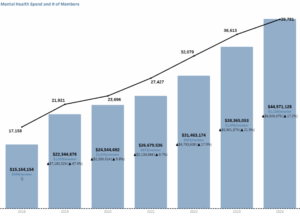Mental and behavioral health services have seen a surge in demand, especially post-pandemic, leading to increased utilization and rising costs for employers. Commercial insurance premiums are projected to rise 6.5% to 9.5% in 2026, the highest increase in 15 years, and mental health services are a significant contributor due to increased demand and provider consolidation. But the cost for ignoring mental and behavioral health is substantial and multifaceted, impacting everything from healthcare expenses to productivity and employee retention. Poor mental health also contributes to high turnover which is expensive – replacing an employee can cost up to 2x their annual salary. And as a double whammy, members with chronic conditions and mental/behavioral health issues cost employers more than double compared to those with only chronic conditions.
Silent Strain, Real Costs: The Business Impact of Mental & Behavioral Health Conditions on the MB Book of Business
For the employers in our data analytics system, the spend on mental and behavioral health has increased steadily since 2018, with double digit increases since 2021. 
Current spend for the most recent 12 months ending Aug 2025 comes in at nearly $50 million dollars or an average cost/claimant of $1,200 – a 16% increase in spend from the prior period.
- Depression was responsible for $14.8 million in spend from 14K members
- Anxiety was responsible for $5.4 million in spend from 20K members
- Behavioral Health was responsible for $29.4 million in spend from 15k members
Additionally, the compounded costs for members with chronic conditions and mental/behavioral health conditions can be staggering. The average cost per diabetic member in our MB book of business is $22,517/diabetic member per year. For those with diabetes and mental health conditions, the average cost is $51,640/diabetic member.
Not only have costs increased, the number of members seeking treatment has also steadily increased. There were 41,351 members – 33% of the entire population – treated for mental and/or behavioral health conditions in the most recent 12 months. Breaking that down it equates to:
- 33% of Employees
- 40% of Spouses
- 29% of Dependents
This is a good reminder of the importance of ensuring that access and communication about mental & behavioral health programs/EAPs needs to reach the members at home, not just the employees.
National Statistics on Additional Hidden Costs to Employers
- Depression and anxiety cost the global economy $1 trillion annually in lost productivity. [www.forbes.com]
- Absenteeism due to depression costs U.S. businesses $44 billion annually. [www.bighealth.com]
- In the U.S., unresolved depression alone leads to a 35% reduction in productivity per affected employee. [get.headspace.com]
- Presenteeism (being at work but not fully functioning) adds further hidden costs. Even if the employee themselves is not suffering from a mental health condition, their family members may be.
- Mental health-related leaves of absence have increased by 300% between 2017 and 2023 – impacting short- and long-term disability claims.
- Low morale due to poor mental health costs U.S. businesses up to $550 billion annually. [www.modernhealth.com]
- 60% of employees report feeling emotionally detached at work. [www.spill.chat]
Mental Health Access
A recent national survey found 33% of insured employees with mental health conditions couldn’t access needed services, with many citing lack of in-network providers and time constraints. Over 60% of employees with mental health conditions visited the ER in the past six months, often due to lack of timely outpatient care. These are the reasons why employers are investing in other options. Nationally, nearly 48% of large employers have increased access to mental health counseling through EAPs or third-party vendors, and 29% have expanded telehealth options. Within the walls of MB, we have many clients that have expanded their EAPs to more robust options, as well as expanded telehealth options for better mental and behavioral health coverage.
The $1 Investment That Returns $4 – Mental Health Matters
Investing in more robust mental & behavioral health solutions are worth the cost. The group mhanational.org has shown that for every $1 invested in mental health treatment, there is a $4 return in improved health and productivity.
McGohan Brabender understands employers are grappling with how to balance access, affordability, and sustainability for mental health options. We are here to collaborate on innovative solutions to ensure mental health care remains impactful, accessible, effective, and financially viable for our clients. Reach out to your account team today for more information.
Written by: Kelly McCall, Manager Health Intelligence Analytics

